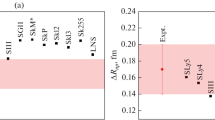Abstract
It is shown that quantization of nuclear motion causes the intrinsic dipole moment of a molecular system to depart from the classical representation, e.g., it is different from zero for symmetrical molecules. A formula is derived for the mean dipole moment ¯p as a function of temperature with allowance for the internal motion of the nuclei, which is functionally related to the dipole moment. Calculations are performed for ammonia with allowance for the inversion splitting, which is due to tunneling between two equivalent equilibrium configurations having their dipole moments in opposite directions. The temperature coefficient of ¯p may be positive or negative, in accordance with the relation between the tunneling frequency and the temperature; the formula usually employed is valid only in the limiting case of low frequencies and high temperatures. A deduction is given for the criterion for instability of the maximally symmetrical configuration with respect to odd nuclear displacements (dipole distortions); this is based on a simple model system having an inversion center, a totally symmetric ground state, and a triply degenerate odd excited state of the T1u type. The experimental consequences of the results are discussed, as well as the concept of symmetry for a molecular system in which the maximally symmetrical configuration is unstable.
Similar content being viewed by others
References
L. Landau and E. Lifshits, Quantum Mechanics [in Russian], Fizmatgiz, Moscow, p. 312, 1963.
H. Eyring, J. Walter, and G. Kimball, Quantum Chemistry [Russian translation], IIL, Moscow, p. 450, 1948.
U. öpik and M. H. Pryce, Proc. Roy. Soc.,A238, 425, 1957.
I. B. Bersuker and B. G. Vekhter, FTT,9, 2652, 1967.
I. B. Bersuker et al., Abstracts of Papers at the the All-Union Conference on Dipole Moments and Molecular Structure [in Russian], Rostov-on-Don, p. 9, 1967.
R. Engelman, “Microscopic theory of ionic dielectrics,” A. E. C. Accesion, A14129, Rept.1, A994, 1964.
C. V. Suryanarayana et al., Monatsh. Chem.,92, 203, 1961.
M. M. Yakshin et al., ZhNKh,6, 2425, 1961.
E. D. Bergman, E. Fisher, and B. Pullman, J. Chem. Phys.,48, 356, 1951.
I. B. Bersuker and A. V. Ablov, Bonds in Coordination Compounds [in Russian], Izd-vo AN Mold-SSR, Kishinev, p. 100, 1962.
Author information
Authors and Affiliations
Rights and permissions
About this article
Cite this article
Bersuker, I.B. Dipole moments of symmetrical molecular systems. Theor Exp Chem 5, 188–191 (1969). https://doi.org/10.1007/BF01109660
Issue Date:
DOI: https://doi.org/10.1007/BF01109660




